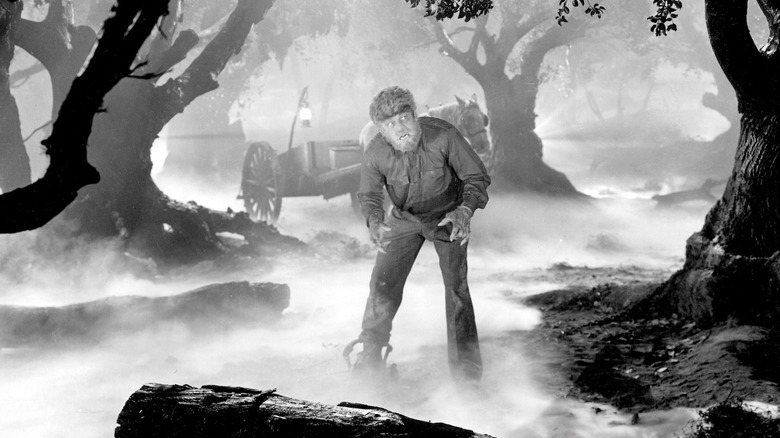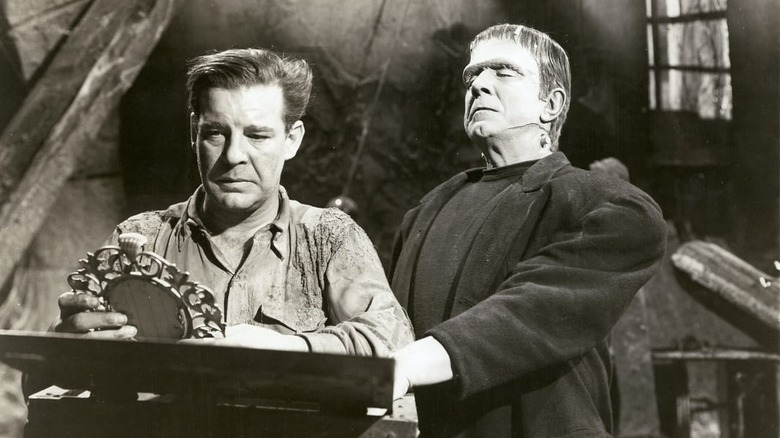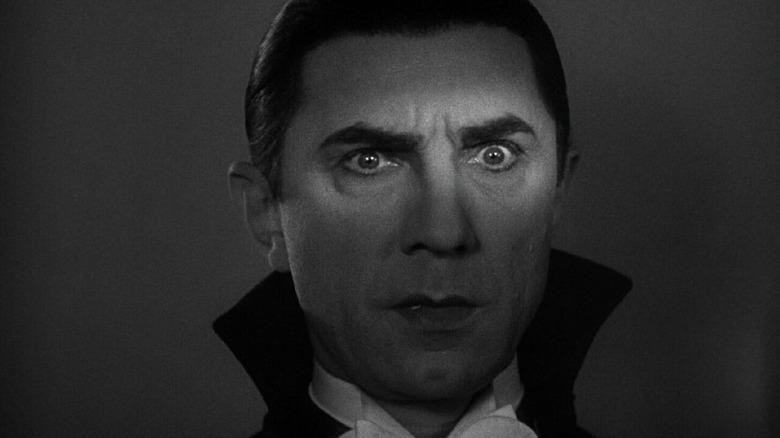The Correct Order To Watch The Wolf Man Movies
George Waggner's 1941 horror film "The Wolf Man" introduced audiences to, essentially, the "second officer" of the Universal Monsters canon. Everyone knows that Dracula is the captain of the monster ship, and that Frankenstein is his first officer (a position he often shares with the Bride). The Wolf Man is always third in command, perhaps serving as a security officer or an enforcer. Mummies, gillmen, invisible men, Dr. Hydes, and other ancillary ghouls serve lower down in the crew.
Watching the original "Wolf Man" film, however, reveals a dark and sad tale about Larry Talbot (Lon Chaney, Jr.) who is attacked by a wolf on a misty night in Wales, afflicting him with the curse of the werewolf. Throughout the year, Larry will transform into an animalistic wolf/human creature and stalk and kill random victims. The tale is terrifying and tragic and inspired many pop culture tales to follow — as well as many nightmares. Werewolf lore had already been introduced into cinemas with the release of "Werewolf of London" in 1935, but it was "The Wolf Man" that pushed werewolves into the mass subconscious. The monster has been a Halloween mainstay ever since.
The Universal Monster movies all spawned a slew of sequels, usually with the title monsters being recast from chapter to chapter. The five "Wolf Man" movies have the distinction of retaining Lon Chaney, Jr. throughout. Chaney also played the mummy in three of the sequels to Karl Freund's "The Mummy," Frankenstein in "Ghost of Frankenstein" and the son of Dracula in "Son of Dracula." He played Larry Talbot in all five of the "Wolf Man" movies. Chaney was a capable actor with a lot of range, but found the bulk of his work playing brutes and monsters.
But where should you start watching the "Wolf Man" movies? We've got a helpful guide below.
The release order
The five "Wolf Man" movies were released in the following order, which is probably the best way to watch them, if you're sticking to the monster's specific movies:
- "The Wolf Man" (1941)
- "Frankenstein Meets the Wolf Man" (1943)
- "House of Frankenstein" (1944)
- "House of Dracula" (1945)
- "Abbott and Costello Meet Frankenstein" (1948)
One will likely notice that the Wolf Man never got a solo sequel to himself. That said, his character arc remained consistent throughout the five movies. In Roy William Nell's "Frankenstein Meets the Wolf Man," the presumed-dead Larry Talbot is exhumed and springs back to life when struck by the light of the full moon. It wouldn't be until "Meets" that werewolves would be associated with full moons. Larry is horrified to have been resurrected and hates that he's still a werewolf. He begins a sad quest to end his own seemingly unending life.
The version of Frankenstein seen in "Meets" is the one played by Bela Lugosi as he was seen in the 1942 film "The Ghost of Frankenstein." In that film, Lugosi played Ygor who sought to have his brain transplanted into Frankenstein's body. Even in the comedy follow-up with Abbott and Costello, Larry would still be depicted as a brooding, tortured figure.
"House of Frankenstein" bears the distinction of being the first film in what today might be called a cinematic universe. That film featured Frankenstein, the Wolf Man, and Dracula, cementing that they all live in the same universe and can all interact. This was about 15 years before the Godzilla series established the same rules, and 68 years before "The Avengers." A similar shtick was used for "House of Dracula" the following year.
Of course, if there's a cinematic universe at play, then we'll need to expand our list somewhat.
The Universal Monsters Cinematic Universe
If one wants to follow all of the Universal Monster movies that exist in the same continuity, then the list is as follows:
- Dracula (1931)
- Frankenstein (1931)
- The Invisible Man (1933)
- Bride of Frankenstein (1935)
- Dracula's Daughter (1936)
- Son of Frankenstein (1939)
- The Invisible Man Returns (1940)
- The Invisible Woman (1940)
- The Wolf Man (1941)
- The Ghost of Frankenstein (1942)
- Invisible Agent (1942)
- Frankenstein Meets the Wolf Man (1943)
- Son of Dracula (1943)
- House of Frankenstein (1944)
- Invisible Man's Revenge (1944)
- House of Dracula (1945)
- Abbott and Costello Meet Frankenstein (1948)
- Abbott and Costello Meet the Invisible Man (1951)
Technically, "Hold That Ghost" (1941), "Abbott and Costello Meet the Killer, Boris Karloff" (1949), "Abbott and Costello Meet Dr. Jekyll and Mr. Hyde (1953), and "Abbott and Costello Meet the Mummy" (1955) are not part of the same monstrous continuity, as Bud Abbott and Lou Costello play different characters in each one. The monsters in each film are also seemingly independent of their cinematic forebears.
Although Abbott and Costello play different characters in their take on "Invisible Man," a single photograph of the original "Invisible" actor Claude Rains connects it directly back to James Whale's 1933 original, meaning the entire six-film "Invisible" series was roped into the series after all.
"The Mummy" and "Creature from the Black Lagoon" are, perhaps surprisingly, unconnected to the above continuity. The sequels to "The Mummy" were also soft reboots that featured a creature named Kharis. In "Abbot/Mummy," the creature is named Klaris. The Mummy, it seems, has been excluded.
Of course, the world of monsters changed with the 1962 release of Bobby "Boris" Pickett's hit single "The Monster Mash," a song that introduced the concept that monsters not only live in the same universe but that they're all friends who party together. But don't forget, "The Monster Mash" is a song about a dance called "The Monster Mash," but it's not the song that the monsters dance to when they're doing The Monster Mash.


